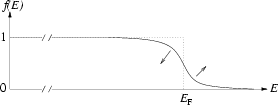Returning now to the FGR expression (2.45),
one might wonder how it is possible to get dissipation (irreversible
growth in the mean energy) at all, given that
the up and down transition rates are always equal!
The answer will be that heating is possible
because the density of states ![]() may differ slightly at the
two energies
may differ slightly at the
two energies
![]() being `pumped' into,
and therefore more states may
fall under the upper delta function than the lower, giving an increase
in mean energy.
However to understand this in more detail,
the up and down transitions (2.45) must be interpreted as giving
diffusion in energy-space.
A diffusion equation for time-evolution of a continuous energy distribution
function
being `pumped' into,
and therefore more states may
fall under the upper delta function than the lower, giving an increase
in mean energy.
However to understand this in more detail,
the up and down transitions (2.45) must be interpreted as giving
diffusion in energy-space.
A diffusion equation for time-evolution of a continuous energy distribution
function ![]() can then be written--from this follows the rate of increase
of mean energy.
can then be written--from this follows the rate of increase
of mean energy.
The linear growth of
![]() resulting from the FGR
means a linear growth in
the second moment (variance) of the distribution about the initial
energy
resulting from the FGR
means a linear growth in
the second moment (variance) of the distribution about the initial
energy ![]() ,
,
So far the evolution of the coefficients ![]() has been entirely coherent
(this is unaffected by the final averaging over initial state
has been entirely coherent
(this is unaffected by the final averaging over initial state ![]() ).
Therefore an
important issue arises: does the energy diffusion eventually stop
at
).
Therefore an
important issue arises: does the energy diffusion eventually stop
at
![]() , when quantum recurrences due to the
discreteness of the spectrum will surely occur?
(For instance, in the kicked rotator system [75],
periodic driving results in saturation of
energy spreading, giving localization).
The answer (discussed in detail in Section 8 and Appendix B of
[46]) is
that preservation of coherent effects
is actually very fragile.
Either
, when quantum recurrences due to the
discreteness of the spectrum will surely occur?
(For instance, in the kicked rotator system [75],
periodic driving results in saturation of
energy spreading, giving localization).
The answer (discussed in detail in Section 8 and Appendix B of
[46]) is
that preservation of coherent effects
is actually very fragile.
Either ![]() can have some slight stochasticity (frequency jitter), or
there is some slight dephasing process (interaction with
the environment, universal in
real systems).
Correlations due to coherence are then lost on
timescales longer than that associated with jitter or dephasing.
So if diffusive spreading and loss of coherence can be
established before
can have some slight stochasticity (frequency jitter), or
there is some slight dephasing process (interaction with
the environment, universal in
real systems).
Correlations due to coherence are then lost on
timescales longer than that associated with jitter or dephasing.
So if diffusive spreading and loss of coherence can be
established before
![]() , the
`breaktime' (i.e. time limit of applicability) of the FGR,
then stochastic spreading will continue for ever.
In other words the `rate equation' (2.49) will remain
valid, and we will not be surprised by recurrence (interference) effects
at long times.
The FGR breaktime will be discussed more in Section 2.2.6.
, the
`breaktime' (i.e. time limit of applicability) of the FGR,
then stochastic spreading will continue for ever.
In other words the `rate equation' (2.49) will remain
valid, and we will not be surprised by recurrence (interference) effects
at long times.
The FGR breaktime will be discussed more in Section 2.2.6.
 |